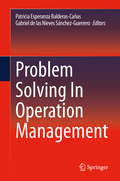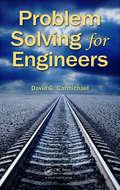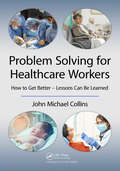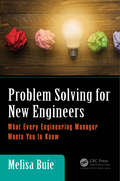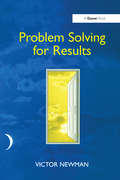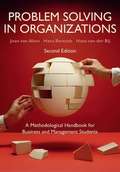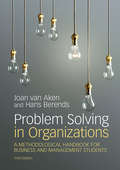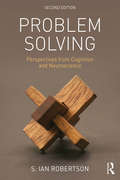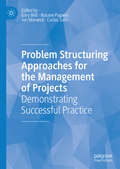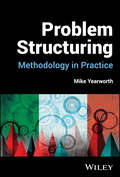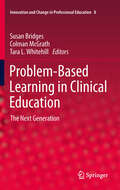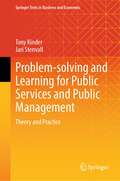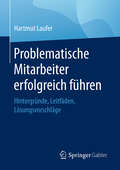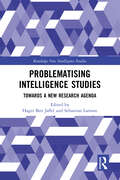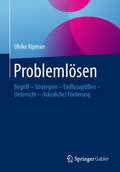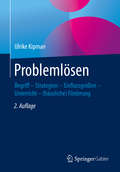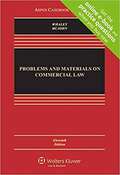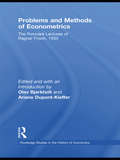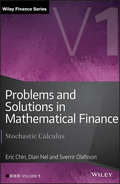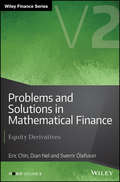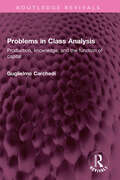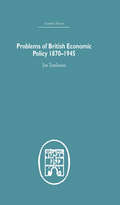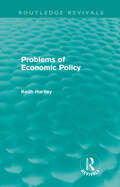- Table View
- List View
Problem Solving In Operation Management
by Patricia Esperanza Balderas-Cañas Gabriel de las Nieves Sánchez-GuerreroThis volume examines problem solving and applied systems aimed at improving performance and management of organizations. The book’s eight chapters are integrated into two parts: methodologies and techniques that discuss complex dynamic analysis of the organizations, participative processes for building trend scenarios, consultancy as a systemic intervention process, processes to promote innovative goals in organizations, and analytical processes and solid mathematical representation systems. The authors also include a model to urban parks location, an analytic model to urban services location, and a system to forecast demand with fussy sets.Describes methodologies to analyze processes in complex dynamic organizations, including as participative, interventional, innovative, and analytical approaches;Clarifies a strategies for providing structure to complex organizations and applying analytical methods to decision making;Illustrates problem holistic solving strategies;Explains how to approach several problems from a holistic point of view and how analyze the subjacent processes to make decisions.
Problem Solving for Engineers
by David G. CarmichaelThis book takes a systematic approach to problem definition, generation of alternative solutions, analysis, and selection of the preferred solution. The book introduces fundamental terms needed to think systematically and undertake systematic problem solving and covers individual and group problem solving. It discusses the selection of the preferred solution involves decision making and fundamental concepts of decision making, including decision making in the presence of multiple criteria and uncertainty. The treatment embodies decision making for sustainability, with its blend of economics, social, and environmental considerations.
Problem Solving for Healthcare Workers: How to Get Better - Lessons Can Be Learned
by John Michael CollinsWhile most healthcare facilities have an extremely high success rate at the most challenging lifesaving work and we all know of friends and relatives who have had supreme care, mistakes are still made and patients’ lives have been put at risk and lost. How often have we heard politicians say after some disastrous report, "Lessons must be learned", but what does this really mean. Will responsible parties carry out a careful cause and effect analysis and methodically get to the root causes of the problem? Will sufficient steps be taken to permanently eradicate those causes and provide a permanent solution so that the problem will not reoccur? This is what is done in the aviation industry with the result that air travel is very safe. The low accident rate is achieved by studying the causes and using the methods of continuous improvement explained in this book. These methods are now becoming better known in the medical profession have been recommended in recent reports but are perhaps misunderstood at operational levels. This book is a basic level manual for those who have never been involved in any form of quality improvement project and is also suitable as a refresher for anyone wishing to familiarize themselves with the various techniques discussed. The aim of this book is to explain what continuous improvement is and why it’s needed; explain how individual departments can explain how and why continuous improvement is important, and helps readers recognize quality control methods in their own workplace and understand how to contribute to existing continuous improvement activities. While many of the case studies and examples are from the NHS, the author includes similar examples from around the world.
Problem Solving for New Engineers: What Every Engineering Manager Wants You to Know
by Melisa BuieThis book brings a fresh new approach to practical problem solving in engineering, covering the critical concepts and ideas that engineers must understand to solve engineering problems. Problem Solving for New Engineers: What Every Engineering Manager Wants You to Know provides strategy and tools needed for new engineers and scientists to become apprentice experimenters armed only with a problem to solve and knowledge of their subject matter. When engineers graduate, they enter the work force with only one part of what’s needed to effectively solve problems -- Problem solving requires not just subject matter expertise but an additional knowledge of strategy. With the combination of both knowledge of subject matter and knowledge of strategy, engineering problems can be attacked efficiently. This book develops strategy for minimizing, eliminating, and finally controlling unwanted variation such that all intentional variation is truly representative of the variables of interest.
Problem Solving for Results
by Victor NewmanIn this thought-provoking book Dr Newman looks beyond the conventional techniques of problem solving to the underlying process. He identifies eight stages and explains how to recognize which technique is appropriate to which stage. On this basis managers can generate solutions at both the personal and the organizational level. He shows: ¢ how to overcome the four main obstacles to developing a balanced problem solving style ¢ how to manage the relationship between problem solving style and stress ¢ how to use physical movement as an aid to problem solving. A unique feature of the book is a Problem Solving Styles Profile that enables each reader to apply the material in the text to improve their own problem solving capability. Written in a lively and practical style and drawing on examples from a wide range of real-life problems, Dr Newman’s book is certain of a warm welcome from managers, team leaders and professionals of every kind.
Problem Solving in Organizations
by Hans van der Bij Hans Berends Joan Van AkenThis concise introduction to the methodology of problem solving in organizations is an indispensable guide to the design and execution of practical business improvement projects in real organizational settings. The methodology is design-oriented and theory-informed. It encourages students to use the theory gained in their disciplinary courses by showing them how to do so in a fuzzy, ambiguous and politically charged, real-life organizational context. The book provides an in-depth discussion of the various aspects and steps of the process of business and organizational problem-solving. Rather than presenting the methodology as a recipe to be followed, the authors demonstrate how to adapt the approach to specific situations and to be flexible in scheduling the work at the various steps in the process. It will be indispensable to MBA and other students who venture outside the university walls to do real-life fieldwork.
Problem Solving in Organizations
by Hans van der Bij Hans Berends Joan Ernst van AkenThis concise introduction to the methodology of Business Problem Solving (BPS) is an indispensable guide to the design and execution of practical projects in real organizational settings. The methodology is both result-oriented and theory-based, encouraging students to use the knowledge gained on their disciplinary courses, and showing them how to do so in a fuzzy, ambiguous and politically charged real life business context. The book provides in-depth discussion of the various steps in the process of business problem solving. Rather than presenting the methodology as a recipe to be followed, the authors demonstrate how to adapt the approach to specific situations and to be flexible in scheduling the work at various steps in the process. It will be indispensable to MBA students who are undertaking their own field work.
Problem Solving in Organizations (3rd Edition): A Methodological Handbook for Business and Management Students
by Hans Berends Joan Van AkenAn indispensable guide enabling business and management students to develop their professional competences in real organizational settings, this new and fully updated edition of Problem Solving in Organizations equips the reader with the necessary toolkit to apply the theory to practical business problems.<P> By encouraging the reader to use the theory and showing them how to do so in a fuzzy, ambiguous and politically charged, real-life organizational context, this book offers a concise introduction to design-oriented and theory-informed problem solving in organizations. In addition, it gives support for designing the overall approach to a problem-solving project as well as support for each of the steps of the problem-solving cycle: problem definition, problem analysis, solution design, interventions, and evaluation. <P>Problem Solving in Organizations is suitable for readers with a wide range of learning objectives, including undergraduates and graduates studying business and management, M.B.A students and professionals working in organizations.<P> Encourages readers to use the theory gained in their disciplinary courses by showing them how to problem solve in fuzzy, ambiguous and politically charged, real-life organizational contexts.<P>Provides an in-depth explanation of the various aspects of organizational problem-solving, showing how to adapt the approach to specific situations and how to be flexible in scheduling the work.<P>Theories are illustrated throughout with examples from real-life problem-solving projects, helping readers to understand the complexities that they will encounter in the field.
Problem Solving: Perspectives from Cognition and Neuroscience
by S. Ian RobertsonThe way that we assess and overcome problems is an essential part of everyday life. Problem Solving provides a clear introduction to the underlying mental processes involved in solving problems. Drawing on research from cognitive psychology and neuroscience, it examines the methods and techniques used by both novices and experts in familiar and unfamiliar situations. This edition has been comprehensively updated throughout, and now features cutting-edge content on creative problem solving, insight and neuroscience. Each chapter is written in an accessible way, and contains a range of student-friendly features such as activities, chapter summaries and further reading. The book also provides clear examples of studies and approaches that help the reader fully understand important and complex concepts in greater detail. Problem Solving fully engages the reader with the difficulties and methodologies associated with problem solving. This book will be of great use to undergraduate students of cognitive psychology, education and neuroscience, as well as readers and professionals with an interest in problem solving.
Problem Structuring Approaches for the Management of Projects: Demonstrating Successful Practice
by Gary Bell Rosane Pagano Jon Warwick Carlos SatoExploring the three levels of project management, this edited collection analyses the practice of problem structuring approaches (PSAs) with an aim to improve organisational adaptability and value creation. By studying these approaches, the authors present techniques for enhancing project management knowledge, informing decision-making and guiding management actions. This book is an insightful and timely read, as it addresses the need for organisations to adapt in order to tackle new challenges within today’s changing business landscape. Undoubtedly useful to those studying project management and operational research, this book is also an important read for managers and decision-makers within organisations as it identifies and examines the effective outcomes of PSAs.
Problem Structuring: Methodology in Practice
by Mike YearworthCurrent perspectives on approaches to problem structuring in operational research and engineering and prospects for problem structuring methods applicable to a wide range of practice. Bridging between operational research (OR) and engineering practice, Problem Structuring: Methodology in Practice is grounded in the emergence of soft OR and its development over time as a distinctively new field, broadening the scope of OR to deal with issues of transforming, strategising, and planning in the context of wicked problems. The book is centred on a methodological framing of intervention processes known as problem structuring methods (PSMs) and the techniques presented are suitable for practitioners across a broad range of disciplines. Written by a highly qualified professor of engineering and management, Problem Structuring: Methodology in Practice contains four linked sections that cover: I. Problem formulation when dealing with wicked problems, justification for a methodological approach, the emergence of soft OR, the relevance of pragmatic philosophy to OR practice. II. Traces debates and issues in OR leading to the emergence of soft OR, comparative analysis of PSMs leading to a generic framework for soft OR practice, addressing practical considerations in delivering PSM interventions. III. Charts the emergence of a problem structuring sensibility in engineering practice, introduces a new PSM based on hierarchical process modelling (HPM) supported by teaching and case studies, makes the case for a processual turn in engineering practice supported by HPM with relevance to OR practice. IV. Evaluation of PSM interventions, survey of applications, use of group support systems, new developments supported by machine learning, recontextualising soft OR practice. Problem Structuring: Methodology in Practice is a thought-provoking and highly valuable resource relevant to all “students of problems.” It is suitable for any UK Level 7 (or equivalent) programme in OR, engineering, or applied social science where a reflective, methodological approach to dealing with wicked problems is an essential requirement for practice.
Problem-Based Learning in Clinical Education: The Next Generation
by Susan Bridges Tara L. Whitehill Colman McgrathDeveloped in the context of health sciences education in the late 1960s, problem-based learning (PBL) is now widely deployed as an education methodology. Its problem-solving, collaborative, student-centred ethos is seen as a more appropriate system of pedagogy than earlier 'chalk-and-talk' modes. Focusing on its use in clinical education, this collection of recent scholarship on PBL examines the ways in which PBL is both conceived and implemented in clinical education. The work has a dual emphasis, research-driven on the one hand, while on the other assessing new methodologies to explore how problem-based curricula support the achievement of students' learning outcomes in the context of clinical education. The chapters draw on studies that explore PBL both theoretically and empirically. The volume's eclecticism capitalises on the growing body of empirical research into PBL evaluations. It balances this with studies analysing the relatively new area of discourse-based research on PBL-in-action, whose focus has been to interrogate the 'how' of student learning in curricula with PBL content.This publication will be of interest to clinical teachers, curriculum designers and those interested in innovations in the scholarship of teaching and learning in PBL curricula.
Problem-solving and Learning for Public Services and Public Management: Theory and Practice (Springer Texts in Business and Economics)
by Jari Stenvall Tony KinderIn this textbook readers will acquire knowledge of problem-solving and learning to enhance both efficiency and the experience of service users in rapidly changing service environments, that can create new service models. Emphasizing that, above all else, individuals are at the centre of services, the book goes deeply into the nature of public services and their logic-of-practice. By applying learning and problem-solving approaches, the reader gains practical capabilities in addition to an appreciation of the latest research literature. Following a multidisciplinary, international approach, the book suggests a new typology of problem-framing and presents many examples of how new service solutions can be created in any public service context. The book offers a conceptual toolkit to understand and analyse dynamically changing services and the application of new technologies. Topics covered include pressing issues surrounding public services, such as e-technology, digitalisation, e-services, artificial intelligence, entrepreneurialism, sustainability, climate, inequality, developing economies, and smart cities. Chapters follow a similar structure: issue, problems, what we know, learning framework, worked example, theory and practice conclusions, as well as teacher and learner notes. Addressing advanced undergraduate and graduate students of public administration, public management, political science, sociology, computer science, and information systems, the book will also be a valuable resource for practitioners, i.e. experts and managers in public organizations, professionals in organizations working at the business and public sectors, consultants, and IT suppliers.
Problem: How to Define Your Decision Problem to Solve the Right Problem
by John S. Hammond Ralph L. Keeney Howard RaiffaThe way you frame your decision at the outset can make all the difference. This chapter describes one of the keys to effective decision making: stating your decision problems carefully, acknowledging their complexity and avoiding unwarranted assumptions and prejudices.
Problematische Mitarbeiter erfolgreich führen
by Hartmut LauferDas Buch befasst sich mit besonderen Problemen bei der Mitarbeiterführung und zeigt, auf welchen Wegen ein partnerschaftlicher Umgang zwischen Führungskräften und Mitarbeitern gefunden werden kann.Auf der Basis aktueller psychologischer Erkenntnisse und seiner langjährigen Erfahrung als Führungskraft beleuchtet der Autor die Hintergründe problematischer Verhaltensweisen von Mitarbeitern und stellt praxiserprobte Führungstechniken und Kommunikationsinstrumente zur Bewältigung der damit einhergehenden Konflikte vor. Der Autor zeigt auf, wie Führungskräften in Mitarbeitergesprächen der schwierige Balanceakt zwischen der Wahrung der Unternehmensinteressen einerseits und der Fürsorgepflicht gegenüber Mitarbeitern andererseits gelingen kann. Daher widmet sich das abschließende Kapitel den besonderen Anforderungen, Risiken und Regeln, die bei problemspezifischen Mitarbeitergesprächen zu bedenken sind – unter anderem beim Kritikgespräch, Schlichtungsgespräch oder Trennungsgespräch. Für jede Art von Mitarbeitergespräch bietet der Band Checklisten und Leitfäden zur Anwendung im Führungsalltag.
Problematising Intelligence Studies: Towards A New Research Agenda (Routledge New Intelligence Studies)
by Hager Ben JaffelThis book offers a new research agenda for intelligence studies in contemporary times. In contrast to Intelligence Studies (IS), whose aim has largely been to improve the performance of national security services and assist in policy making, this book takes the investigation of the new professionals and everyday practices of intelligence as the immediate point of departure. Starting from the observation that intelligence today is increasingly about counter-terrorism, crime control, surveillance, and other security-related issues, this book adopts a transdisciplinary approach for studying the shifting logics of intelligence, how it has come to involve an expanding number of empirical sites, such as the police, local community, prison and the Internet, as well as a corresponding multiplicity of new actors in these domains. Shifting the focus away from traditional spies and Anglo-American intelligence services, this book addresses the transformations of contemporary intelligence through empirically detailed and theoretically innovative analyses, making a key contribution to existing scholarship. This book will be of much interest to students of intelligence studies, critical security studies, foreign policy, and International Relations.
Problemlösen: Begriff – Strategien – Einflussgrößen – Unterricht – (häusliche) Förderung
by Ulrike KipmanProblemlösen gilt als eine der Schlüsselqualifikationen des 21. Jahrhunderts. Es geht beim Problemlösen nicht nur darum, Informationen sinnvoll zu vernetzen, dynamisch in Beziehung zu setzen, Wahrscheinlichkeiten zu berechnen und eine Kette richtiger Entscheidungen zu treffen, sondern auch vielfach darum, eine Vielzahl an Außenkriterien zu berücksichtigen und ein entsprechendes „Weltwissen“ an den Tag zu legen. Dieses Buch soll die Frage beantworten, wie man zu einem guten Problemlöser / einer guten Problemlöserin werden kann bzw. warum bestimmte Personen bei der Lösung von Problemen erfolgreicher sind als andere. Nach einer umfassenden Zusammenstellung der Literatur zu diesem Thema werden Einflussgrößen auf das Problemlösen analysiert und miteinander abgeglichen und Ideen für den Unterricht in der Primarstufe und Sekundarstufe I präsentiert. Zudem werden verschiedene Arten des Unterrichts im Hinblick auf die Wirksamkeit für unterschiedliche Personengruppen diskutiert, dies vor dem Hintergrund, dass nicht nur Problemstellungen stark variieren sondern auch die Problemlöser/innen. Eine Handreichung mit Brettspielen, die die Kriterien des Problemlösens erfüllen, ist ebenfalls Teil dieses Buches. Letztendlich wird ein Modell vorgeschlagen, welches erfolgreiches Problemlösen vielschichtig zu erklären versucht.
Problemlösen: Begriff – Strategien – Einflussgrößen – Unterricht – (häusliche) Förderung
by Ulrike KipmanProblemlösen gilt als eine der Schlüsselqualifikationen des 21. Jahrhunderts. Es geht beim Problemlösen nicht nur darum, Informationen sinnvoll zu vernetzen, dynamisch in Beziehung zu setzen, Wahrscheinlichkeiten zu berechnen und eine Kette richtiger Entscheidungen zu treffen, sondern auch vielfach darum, eine Vielzahl an Außenkriterien zu berücksichtigen und ein entsprechendes „Weltwissen“ an den Tag zu legen. Dieses Buch soll die Frage beantworten, wie man zu einem guten Problemlöser / einer guten Problemlöserin werden kann bzw. warum bestimmte Personen bei der Lösung von Problemen erfolgreicher sind als andere. Nach einer umfassenden Zusammenstellung der Literatur zu diesem Thema werden Einflussgrößen auf das Problemlösen analysiert und miteinander abgeglichen und Ideen für den Unterricht in der Primarstufe und Sekundarstufe I präsentiert. Zudem werden verschiedene Arten des Unterrichts im Hinblick auf die Wirksamkeit für unterschiedliche Personengruppen diskutiert, dies vor dem Hintergrund, dass nicht nur Problemstellungen stark variieren sondern auch die Problemlöser/innen. Eine Handreichung mit Brettspielen, die die Kriterien des Problemlösens erfüllen, ist ebenfalls Teil dieses Buches. Letztendlich wird ein Modell vorgeschlagen, welches erfolgreiches Problemlösen vielschichtig zu erklären versucht. In der 2. Auflage wurden alle Kapitel überarbeitet und an den neuesten Kenntnisstand zum Thema Problemlösen angepasst. Die Kapitel zur schulischen und häuslichen Förderung der Problemlösekompetenz wurden stark erweitert und es werden nun eine Vielzahl an neuen Aufgaben und Spielen präsentiert, die beim Fördern von Problemlösen eine wertvolle Unterstützung leisten können. Das Kapitel zur Kombinatorik wurde nach der Rückmeldung von Studierenden und Kollegen komplett umstrukturiert und ist nun verständlicher und übersichtlicher aufgebaut.
Problems and Materials on Commercial Law (Aspen Casebook Series)
by Douglas J. Whaley Stephen M. McJohnClear, lucid, and extremely accessible, Problems and Materials on Commercial Law helps students understand black letter law and the statutory language in the Uniform Commercial Code. Concise yet comprehensive coverage includes the most recent case and statutory developments in all fundamental areas of Commercial Law, including sales, payment systems, and secured transactions. A sensible, flexible organization follows the order of UCC Articles 2, 3, 4, and 9, and is adaptable to many teaching styles. Drawing on experience in both teaching and writing, the authors provide thorough and practical coverage using a popular problem approach. <p><p>The text s effective format, manageable length, and inclusion of the most important cases make Problems and Materials on Commercial Law concise and efficient. A Teacher s Manual provides sample syllabi, answers to all the problems in the text, and suggestions on the best ways to teach various topics.
Problems and Methods of Econometrics: The Poincaré Lectures of Ragnar Frisch 1933 (Routledge Studies in the History of Economics)
by Ragnar FrischThe development of economics changed dramatically during the twentieth century with the emergence of econometrics, macroeconomics and a more scientific approach in general. One of the key individuals in the transformation of economics was Ragnar Frisch, professor at the University of Oslo and the first Nobel Laureate in economics in 1969. He was a co-founder of the Econometric Society in 1930 (after having coined the word econometrics in 1926) and edited the journal Econometrics for twenty-two years. The discovery of the manuscripts of a series of eight lectures given by Frisch at the Henri Poincaré Institute in March–April 1933 on The Problems and Methods of Econometrics will enable economists to more fully understand his overall vision of econometrics. This book is a rare exhibition of Frisch’s overview on econometrics and is published here in English for the first time. Edited and with an introduction by Olav Bjerkholt and Ariane Dupont-Kieffer, Frisch’s eight lectures provide an accessible and astute discussion of econometric issues from philosophical foundations to practical procedures. Concerning the development of economics in the twentieth century and the broader visions about economic science in general and econometrics in particular held by Ragnar Frisch, this book will appeal to anyone with an interest in the history of economics and econometrics.
Problems and Solutions in Mathematical Finance
by Sverrir Olafsson Eric Chin Dian Nelnd those involved in teaching in this field of study, Stochastic Calculus provides a valuable reference book to complement one's further understanding of mathematical finance.
Problems and Solutions in Mathematical Finance: Equity Derivatives, Volume 2
by Eric Chin Dian Nel Sverrir ÓlafssonDetailed guidance on the mathematics behind equity derivatives Problems and Solutions in Mathematical Finance Volume II is an innovative reference for quantitative practitioners and students, providing guidance through a range of mathematical problems encountered in the finance industry. This volume focuses solely on equity derivatives problems, beginning with basic problems in derivatives securities before moving on to more advanced applications, including the construction of volatility surfaces to price exotic options. By providing a methodology for solving theoretical and practical problems, whilst explaining the limitations of financial models, this book helps readers to develop the skills they need to advance their careers. The text covers a wide range of derivatives pricing, such as European, American, Asian, Barrier and other exotic options. Extensive appendices provide a summary of important formulae from calculus, theory of probability, and differential equations, for the convenience of readers. As Volume II of the four-volume Problems and Solutions in Mathematical Finance series, this book provides clear explanation of the mathematics behind equity derivatives, in order to help readers gain a deeper understanding of their mechanics and a firmer grasp of the calculations. Review the fundamentals of equity derivatives Work through problems from basic securities to advanced exotics pricing Examine numerical methods and detailed derivations of closed-form solutions Utilise formulae for probability, differential equations, and more Mathematical finance relies on mathematical models, numerical methods, computational algorithms and simulations to make trading, hedging, and investment decisions. For the practitioners and graduate students of quantitative finance, Problems and Solutions in Mathematical Finance Volume II provides essential guidance principally towards the subject of equity derivatives.
Problems in Class Analysis: Production, knowledge, and the function of capital (Routledge Revivals)
by Guglielmo CarchediFirst published in 1983, Problems in Class Analysis presents a coherent theory of labour’s domination by capital, based upon the notion of the capitalist nature of both the product relations and of the productive forces themselves, including science and technology. The author demonstrates that all knowledges are a product, direct or indirect, of economic relations, so that different knowledges will be the product of different social classes as determined by their position within economic production relations. By posing and re-solving fundamental problems in class analysis, Dr. Carchedi forms a bridge between the theory of the production process and contemporary debates in economics, sociology and epistemology.
Problems of British Economic Policy, 1870-1945
by Jim TomlinsonMost historical accounts of economic policy set out to describe the way in which governments have attempted to solve their economic problems and to achieve their economic objectives. Jim Tomlinson, however, focuses on the problems themselves, arguing that the way in which areas of economic policy become ‘problems’ for policy makers is always problematic itself, that it is never obvious and never happens ‘naturally’. This approach is quite distinct from the Marxist, the Keynesian or the neo-classical accounts of economic policy, the schools of thought which are described and criticized in the introduction. Subsequent chapters use the issues of unemployment, the gold standard and problems of trade and Empire to demonstrate that these competing accounts all obscure the true complexities of the process. Because they adhere to simple assumptions about the role of economic theory or of ‘vested interests’ previous histories have been unable adequately to explain the dramatic change after the First World War in attitudes to unemployment, for instance, or the decision to return to gold in 1925. Jim Tomlinson surveys the institutional circumstances, the conflicting political pressures and the theories offered at the time in an attempt to discover the conditions which characterized the questions as economic problems and contributed to the choice of ‘solutions’. The result is a sophisticated and intellectually compelling account of matters which have remained at the forefront of political debate since its first publication in 1981.
Problems of Economic Policy (Routledge Revivals #No. 3)
by Keith HartleyFirst published in 1977, this is an applied economics text, in which the basic theory of any introductory economics couurse is applied to a whole range of UK macro- and micro-economic policy issues. The book is designed specifically for first and second year university students, with the aim of demonstrating the relevance of theory to policy, how theory can be applied to policy problems and, in the process, to improve their understanding of the theory itself.
